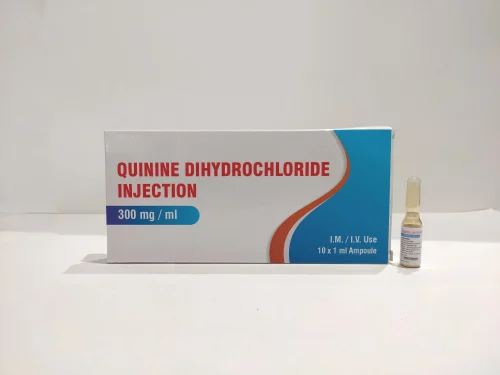Skip to content
📌 Description:
- Quinine is a natural alkaloid derived from the bark of the Cinchona tree.
- It is used as an antimalarial drug, particularly for severe Plasmodium falciparum infections.
- The injection contains 300 mg of quinine salt (commonly quinine dihydrochloride or gluconate) per mL.
- It acts by interfering with the parasite’s ability to digest hemoglobin in red blood cells.
- The preparation is usually for intravenous (IV) use in hospital settings.
🧪 Nature:
- Quinine is classified as a cinchona alkaloid and antimalarial agent.
- It is available as a sterile aqueous solution, usually clear to slightly yellow.
- The injectable form is water-soluble and often comes in ampoules or vials.
- The drug exhibits bitter taste and light sensitivity.
- It has anti-parasitic, antipyretic, and mild analgesic properties.
💡 Advantages:
- Effective in treating severe or complicated malaria, especially in resistant strains.
- Rapid onset of action when given parenterally.
- Life-saving in cerebral malaria and multi-organ involvement.
- Available in settings where newer antimalarials (like artesunate) may not be.
- Often included in national malaria control programs in endemic regions.
💊 Uses:
- Treatment of severe Plasmodium falciparum malaria (especially IV route).
- May be used as part of combination therapy with antibiotics like doxycycline or clindamycin.
- Occasionally used for Babesiosis in rare cases.
- Emergency antimalarial in settings lacking access to artesunate.
- Used in hospital ICU settings for critical care malaria management.
🏥 Storage:
- Store at 25°C (77°F); excursions permitted to 15–30°C.
- Protect from light and freezing.
- Keep ampoules or vials in the original outer packaging until use.
- Should be stored in a secure, sterile location.
- Check for any precipitation or discoloration before administration.
Call Now Button

